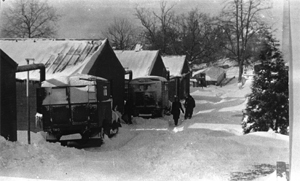Telecommunications Research Establishment
The British Telecommunications Research Establishment (TRE for short, German: Development Facility for Telecommunications) was founded during the Second World War in May 1940 in Worth Matravers , about five kilometers west of Swanage , as a research center of the British Air Force ( RAF ) for the further development of RADAR technology . To prevent German attacks, similar to the successful British Operation Biting , it was relocated to Malvern , Worcestershire in August 1942 .
The starting point of the British RADAR development in 1935 was the Aeronautical Research Committee in Orfordness near Ipswich under the direction of Sir Henry Tizard . This working group first moved to the nearby Bawdsey Research Station in 1936 and finally moved to Worth Matravers in the early summer of 1940 after the chain home was in a hurry to go into operation .
The TRE worked closely with Reginald Victor Jones in MI6 to develop measures against the superior German navigation technology and the associated night bombing attacks.
Another important development of the TRE was the RADAR device H2S . It used the newly developed magnetron and allowed the British bombers to bomb precisely at night and in poor visibility.
In the period from 1942 to 1945 the workforce grew from approx. 2000 employees to over 3500 employees.
In the post-war period, the TRE was initially merged with other research institutions and renamed several times. The establishment , created in 1953 by merging with the Army Radar Establishment , was initially referred to as the Radar Research Establishment and from 1957 as the Royal Radar Establishment . In 1976, after merging with the Army Signals Research and Development Establishment (SRDE), this resulted in the Royal Signals and Radar Establishment , which was subsequently merged into the Defense Evaluation and Research Agency (DERA) in 1992, which in turn became the private company QinetiQ and the state authority in 2001 Defense Science and Technology Laboratory (DSTL).
Known employees
- Alan Blumlein
- BV Bowden, Baron Bowden (Bertram Vivian Bowden)
- RJ Dippy
- Geoffrey stupid
- Antony Hewish
- Alan Hodgkin
- Tom Kilburn
- Bernard Lovell
- YES Ratcliffe
- Alec H. Reeves
- Martin Ryle
- Francis Graham-Smith
- Maurice Wilkes
- Sir Frederic Calland Williams
literature
- Ernest H. Putley: The History of the RSRE. Physics in Technology 16 (1985), pp. 5-18. IOPscience
Web links
- TRE History , Penley Radar Archives
- Purbeck Radar ~ Early Radar Development in the UK Origin of TRE in Purbeck, Dorset.
- Radar Recollections 1934-1944 , Center for the History of Defense Electronics, Bournemouth University
Individual evidence
- ↑ Ernest H. Putley: The History of the RSRE. Physics in Technology 16: 5-18 (1985); here: p. 5.
